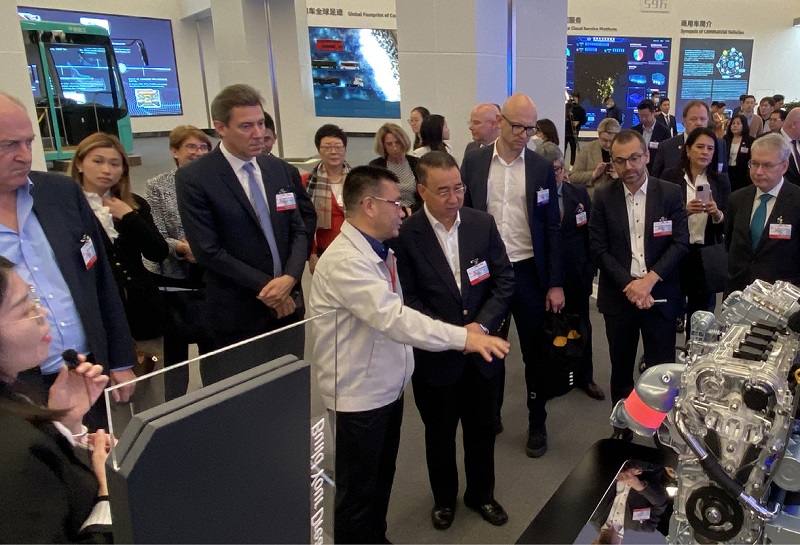
Foreign diplomats in Hong Kong and representatives from the business community visit cities in the Guangdong-Hong Kong-Macao Greater Bay Area for opportunities in March 2023.
The 2024 sessions of China’s top legislature and political advisory body exuded a strong sense of confidence in China’s ability to steer its course toward modernization in spite of the headwinds created by the hysterical reaction of some in the West over Beijing’s emergence as a world power.
This was clear from the government work report tabled by Chinese Premier Li Qiang. It set the targets for China in 2024, with a predicted growth rate of around 5 percent, creating over 12 million new urban jobs, and keeping the consumer price index increase of about 3 percent, a very low rate of inflation compared to almost all other nations. Despite the decline in world trade and a slowdown of domestic consumption, the real key to the development course has been indicated by the concept of developing “new quality productive forces,” an idea that President Xi Jinping had introduced during a trip to northeast China last year. The concept involves lifting the economy to a new platform of development by raising the level of technology.

Consumers shopping for lipstick inside a shopping mall in Huhhot of Inner Mongolia on March 8, 2024, International Women’s Day.
The central authorities have committed to channeling funding to support the endeavor. In the government work report, Li announced that China would issue ultra-long special treasury bonds to support major national strategies and build up security capacity in key areas, which involve high-technology projects. This is not, however, a bailout or some form of qualitative easing. Rather it is a concerted effort to focus on those areas which have the greatest potential for lifting the economy to a higher level.
At a press conference of China’s key economic officials held on the sidelines of the National People’s Congress, the top legislature, on March 6, Zheng Shanjie, director of the National Development and Reform Commission, said these “ultra-long bonds” would be targeted to science and technology innovation, integrated urban-rural development, high-quality population development, and food and energy security.
It was also clear from the press conference and the government work report that China welcomes foreign investment and is instituting the necessary reforms to create a level playing field for all participants, domestic as well as foreign ones. The government will also open up new areas for investment by foreign companies.
The concept of new quality productive forces takes the innovation-driven development policy, which has been the general direction of China’s economic policy over the last few decades, to a higher level. It was also announced that investment in science and technology will increase by 10 percent this year, a significant jump from previous years. Local and provincial governments as well as enterprises, both state-owned and privately owned, are also encouraged to increase their R&D spending. This will allow China to develop the hi-tech products the West is trying to seal off from China because of the “technology rivalry” alleged by the United States, and followed by some of its allies. This process will also create a higher skill level in the labor force, which will allow China to boost productivity.
The chilly winds blowing from across the Pacific have not dampened China’s desire to maintain cordial and friendly relations with all countries, including the United States. Foreign Minister Wang Yi, who gave a press conference on the sidelines of the “Two Sessions” on March 7, made this quite clear. He said, “The China-U.S. relationship is critical to the well-being of the two peoples, and to the future of humanity and the world. No matter how the international landscape evolves, China always keeps its U.S. policy stable and consistent, and always handles the relationship with a sense of responsibility for history, for the people and for the world.”

People seeking to locate a job at a large-scale job fair in the City of Taiyuan, Shanxi Province on March 2, 2024.
 He also pointed out that the U.S. is still exerting pressure to prevent China from purchasing hi-tech products from the West: “The U.S. has been devising various tactics to suppress China and kept lengthening its unilateral sanctions list, reaching bewildering levels of unfathomable absurdity.” The challenge did not come from China but from the U.S. itself, and he hoped Washington would “fulfill its commitments.”
He also pointed out that the U.S. is still exerting pressure to prevent China from purchasing hi-tech products from the West: “The U.S. has been devising various tactics to suppress China and kept lengthening its unilateral sanctions list, reaching bewildering levels of unfathomable absurdity.” The challenge did not come from China but from the U.S. itself, and he hoped Washington would “fulfill its commitments.”Despite the geopolitical problems, Wang remained confident about the future, saying, “The evolution of the international situation in recent years shows again and again that the number-one reality in today’s world is that all countries rise and fall together, and that the sure path to meeting the challenges is mutual assistance and win-win cooperation. More and more countries and peoples have come to realize that the future of humanity should be decided by all countries together, and that the future of the world should be built by all peoples together. China is ready to work with all countries to build an open, inclusive, clean, and beautiful world of lasting peace, universal security, and shared prosperity. The road ahead may be tortuous, but the future is bright.”
China’s actions to bring to an end some of the most pressing conflicts of our age corroborate what the foreign minister said. Be it China’s call for a ceasefire in Gaza or its attempts to mediate peace between Ukraine and Russia, China is serving as an anchor of stability in a world engulfed in geopolitical rivalry and conflict. 
William Jones is a former White House correspondent for Executive Intelligence Review and a non-resident fellow of the Chongyang Institute for Financial Studies under Renmin University of China.